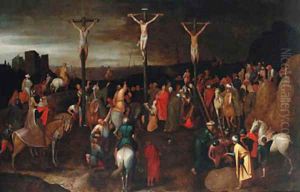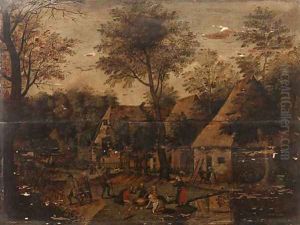Pieter Breughel II Paintings
Pieter Brueghel II, often referred to as Pieter Brueghel the Younger or 'Hell Brueghel' due to his penchant for depicting scenes of the underworld, was a Flemish painter born in 1564 in Brussels, which was then part of the Habsburg Netherlands. He was the eldest son of the renowned artist Pieter Bruegel the Elder and Mayken Coecke van Aelst. His grandfather was the painter Pieter Coecke van Aelst. Pieter Brueghel II's artistic style was significantly influenced by his father, and he spent his career perpetuating his father's style and subjects, with a particular focus on genre paintings and landscapes. He was a member of a dynasty of painters, which also included his brother Jan Brueghel the Elder, who was famed for his detailed floral still lifes and landscapes.
Pieter Brueghel II is best known for his detailed copies and variations of his father's works, which has made the attribution of some pieces challenging for art historians. However, he also produced original works and was known for his own innovations in compositions. He was a prolific artist, and his paintings were in high demand during his lifetime. Brueghel II's works often depicted peasant life, religious themes, and proverbial subjects, and he was skilled in capturing the essence of various human activities and festivities, revealing aspects of 16th and early 17th-century life in the Low Countries.
Brueghel II's painting career spanned over four decades. He became a master in the Antwerp Guild of St. Luke in 1585 and ran a large workshop that helped disseminate his and his father's style throughout the region. His works were widely copied and imitated, which is a testament to their popularity and influence. Despite living in the shadow of his father's formidable reputation, Pieter Brueghel II managed to maintain a distinct artistic identity and contributed to the Brueghel family's enduring legacy in the history of Northern Renaissance art. He passed away in Antwerp, where he spent most of his life and career, sometime between 1637 and 1638.

